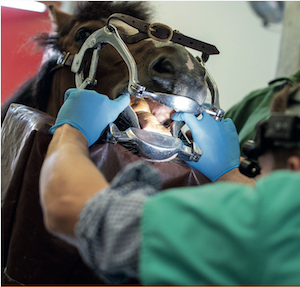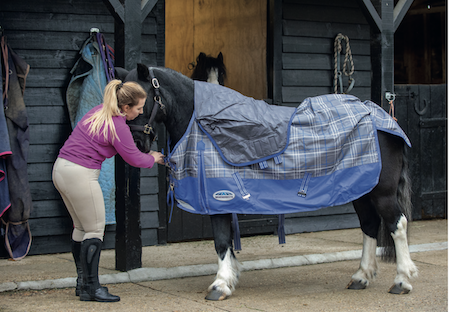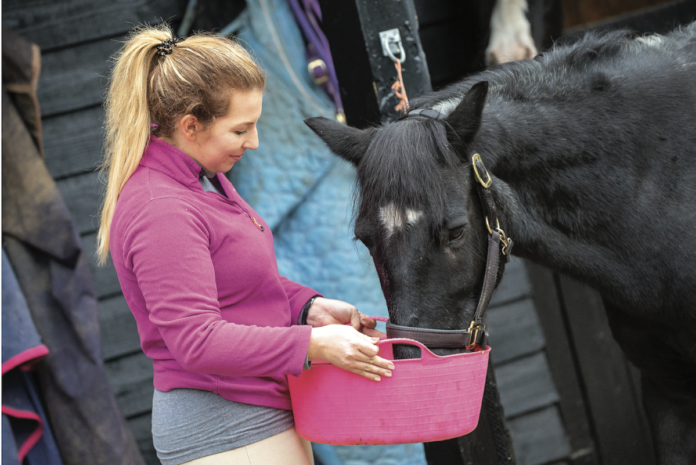TIPS FOR TACKLING WINTER WEIGHT LOSS IN SENIOR HORSES

By Sarah Nelson, nutritionist at Spillers
AMTRA is required by the Veterinary Medicines Regulations to ensure its RAMAs/SQPs undertake CPD. All RAMAs/SQPs must earn a certain number of CPD points in a given period of time in order to retain their qualification. RAMAs/SQPs who read this feature and submit correct answers to the questions below will receive two CPD points. For more about AMTRA and becoming a RAMA/SQP, visit www.amtra.org.uk
Ageing is highly individual and while some senior horses maintain healthy and active lives well into their twenties or even thirties, others show signs of ageing by their mid- teens.
As a result, there’s no one-size-fits-all approach for tackling or preventing weight loss. Improving your knowledge of the many factors at play will help you to offer customers the best possible advice this winter.
IDENTIFYING THE CAUSE
Senior horses may lose weight for a number of reasons so it’s important to ensure underlying clinical conditions can be ruled out.
In healthy horses with good teeth, nutritional management should focus on providing ad lib forage (as much as the horse/ pony will eat) and supplying additional energy or ‘calories’ through appropriate feed.
Research has shown that feeding a meal high in starch and/or sugar may lead to an exaggerated insulin response, even in healthy senior horses. In practice, this means choosing feeds containing low or restricted levels of starch and sugar, which may be beneficial for all senior horses. Being proactive is by far the best strategy and allowing poor doers to enter the winter at a body condition score of 6/9 (provided they are not laminitic) may help to buffer excess weight loss.
TROUBLESOME TEETH

Dental issues, which include lost or worn teeth, diastemas (gaps between the teeth), inflamed gums and even arthritis of the jaw may lead to weight loss as well as digestive issues such as choke, loose droppings and colic.
Older horses may need more frequent dental check-ups, but owners should look out for any signs of pain or difficulty chewing between visits which (in addition to weight loss and digestive issues) include:
- Quidding
- Reluctance or refusal to eat
- Bad breath
- Obvious pain or discomfort when eating or always chewing on one side
- Facial swellings
- Long fibre, whole cereal grains or partially/ undigested feed in droppings
- Reluctance to accept the bit and/or changes in ridden behaviour
The most suitable feed(s) will vary between individuals and will depend, amongst other factors, on the dental issue(s) involved and whether a replacement for ‘bucket feed’ and/ or forage is needed. Soft, short chopped fibres may be suitable for some, while others may need a mash, potentially to replace 100% of their diet.
MASHES
The majority of cubes and pellets can be soaked before feeding but quick-soaking mashes may be a more convenient option. Some products are suitable to feed as a replacement for compound feed (mix and cubes) while others can be fed as a full or partial replacement for hay/ forage.
Regardless of the product used, owners should weigh their feeds before soaking – the increase in volume post-soaking can make it easy to over-estimate how much is fed.
Using warm water can speed-up the soaking time and may be preferred by some seniors, especially those with sensitive teeth. If you suffer from sensitive teeth yourself, the last thing you want to do is tuck into an ice-cream!
TIPS FOR FEEDING A HAY/FORAGE REPLACER
- Forage replacers are essential for those unable to manage long fibre (grass, hay and haylage)
- Where possible, include short chopped fibre to increase eating time/chewing as this supports gastric health and mental well- being
- Quick-soaking mashes are ideal for those who can no longer manage short chopped fibre or cubes
- Some products are suitable for feeding as full hay replacers whilst others, including unmolassed sugar beet, alfalfa and grass nuts, are only suitable for feeding as partial forage replacers
- Remember, grass-based products may be high in water soluble carbohydrate (WSC) or ‘sugar’, even if they are molasses free
- Hay replacers should ideally be divided into a minimum of four meals for horses without access to grazing
- Some horses learn to regulate their intake but small, frequent meals and dividing rations between multiple buckets may help to encourage ‘grazing’
- Horses fed hay replacers may need to be separated from their field companions at mealtimes to prevent ‘sharing’ or bullying
LAMINITIS
A diet low in non-structural carbohydrate (NSC) or ‘starch and sugar’ is key to managing those prone to laminitis. In general, this means restricting or removing grazing, choosing fibre-based feeds and ideally feeding a low WSC hay or a hay replacer low in starch and sugar. Feeds high in oil provide an excellent alternative to cereal-based feeds for those who need additional calories – oil is approximately 2.5 times higher in calories compared to cereal grains but starch and sugar free! Speak to a nutritionist before giving specific advice, especially in cases of severe insulin dysregulation.
Although spring and autumn are ‘high risk’ in terms of grazing, winter pasture may present a hidden danger for laminitics too, especially when exposed to bright sunlight in conjunction with cold temperatures. Grass will continue to photosynthesise (and therefore produce sugar) whenever the sun is shinning but is unable grow when the temperature drops below 5°C, causing potentially high levels of WSC to accumulate.
PPID
Horses and ponies with PPID (pituitary pars intermedia dysfunction) or ‘Cushing’s syndrome’ may be at increased risk of laminitis, especially if they have insulin dysregulation, so not all ‘conditioning feeds’ will be suitable.
A heavy worm burden can lead to weight loss in horses of all ages but seniors with PPID may have increased faecal egg counts and require more frequent monitoring and/or treatment.

TEMPERATURE CONTROL
Ensuring poor doers are appropriately rugged will help to prevent them wasting valuable energy (calories) keeping warm.
That said, older horses may have difficulty regulating their body temperature and as a result, need their rugs changing more frequently, especially if the weather is changeable or unseasonably mild. Getting too hot can reduce appetite, especially in horses and ponies with PPID and may contribute to weight loss.
REDUCED APPETITE
Dental issues and a number of underlying clinical conditions can cause horses to go off their feed or forage.
Pain from general joint disease can affect appetite as well as overall welfare so owners should discuss a pain management programme with their vet. Arthritis in the neck or forelimbs may make grazing or lowering the head uncomfortable, so it may be helpful to suggest your customers try offering feed, forage and water from raised buckets, mangers and troughs.
Changes in routine or being separated from companions can make some seniors reluctant to tuck into their feed or forage while others simply become fussy with age.
FUSSY FEEDERS
If underlying clinical conditions have been ruled out, owners may wish to try adding warm water or herbs such as garlic, mint or fenugreek to their horse’s feed. Alternatively, consider recommending a suitable feed that already contains an added flavour.
HERD DYNAMICS
Horses benefit in many ways by living in a herd environment but as they get older, they may be pushed down the pecking order by younger horses which means they may lose out when it comes to feed, water and shelter.
Owners should choose field companions carefully, look out for signs of bullying and feed horses separately if needed. Ideally a large water trough or more than one water supply should be provided in the field too.
MONITORING IS KEY!
Paying close attention to their horse’s weight, body condition and behaviour will help owners to identify whether any changes in diet or management may be needed, so suggest customers monitor bodyweight weekly and body condition score fortnightly.
While some loss of muscle often occurs with weight loss,
it’s important to remember that body condition scoring is an assessment of fat, not muscle/topline. In general, muscle feels firm and fat feels soft but a loss of muscle mass in senior horses can sometimes be mistaken for a loss of body fat.
Those with PPID may have regional fat deposits such as a large crest or fat pads on the loins despite being thin over-all. This can sometimes be mistaken for generalised obesity and lead to the diet being restricted too severely. Remember that rugs and thick winter coats can hide a multitude of sins!











